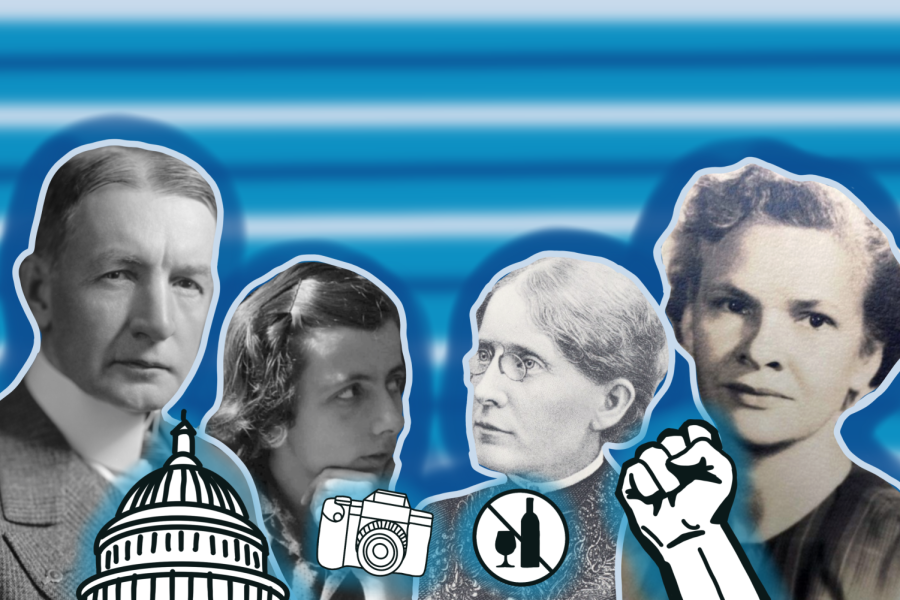A look into Evanston’s famous historical figures
From Vice President Charles Gates Dawes to activist Francis Willard, a number of historical figures in U.S. history have called Evanston home.
May 25, 2023
From a vice president to local activists, several historical figures have called Evanston home at some point in their lives. Here’s a look at some of these noteworthy people and how they have shaped Evanston’s cultural landscape, 160 years after its founding.
Vice President Charles Gates Dawes
If you take a stroll near Lake Michigan on Greenwood Street, you’ll wind up across the street from the Charles Gates Dawes House. This spot is home to the Evanston History Center and is named after Charles Gates Dawes, the 30th vice president of the U.S. and a Nobel Peace Prize winner. Dawes lived with his family in the Chateauesque mansion on Greenwood Street throughout his adult life until he died in 1951.
Besides serving as Calvin Coolidge’s Vice President from 1925 to 1929, Dawes served in four presidential administrations and was appointed ambassador to the United Kingdom in 1929. In 1944, he donated his home to Northwestern University intending it to be used as the home of the Evanston Historical Society. Later, in 2009, the University donated the home to the Evanston History Center. Tours of the house still occur today.
Frances Willard
With Evanston’s deep roots to the Women’s Christian Temperance Union, the city was home to the organization’s second president, Francis Willard, for much of her adult life. Willard moved to Evanston to attend the North-Western Female College where she graduated from in 1859 and became NU’s first dean of women in 1873.
As a 19th-century social reformer, Willard was a leading figure in the Prohibition and temperance movements, and joined the Alpha Phi sorority in 1875. Willard Residential College at NU’s Evanston campus is named after her.
Mayme Spencer
Elected as Evanston’s first Black female council member in 1963, Mayme Spencer helped pass Evanston’s fair housing ordinance in 1968, which allowed Black residents to buy homes throughout the city. Previous to the ordinance’s passage, Black Evanston residents were denied housing in certain parts of the city.
Spencer, who served two terms as Evanston’s 5th ward councilmember, practiced law and was active in the local civil rights movement. She was involved in the League of Women Voters, the NAACP, the ACLU, the governor-appointed Illinois Board of Regents and the Illinois Commission on Race Relations.
Edwin Bush Jourdain Jr.
In 1931, Edwin Bush Jourdain Jr., a civil rights activist and journalist, became the first Black person to be elected as an alderperson in Evanston. Throughout his 14 years representing the 5th Ward, he fought for the integration of beaches and theaters in the city and organized sit-ins for racial equality.
A Massachusetts native, Jourdain graduated from Harvard University in 1921 and served in editor roles at the Chicago Defender and Chicago Bee in the 1920s. Jourdain’s legacy in Evanston had been commemorated with his house at 2032 Darrow Avenue being named an African American heritage site. The Fleetwood-Jourdain Center in the city is also named for the journalist.
Charles H. Pajeau and Robert Pettit
Charles H. Pajeau and Robert Pettit lived in Evanston in the early 1900s and teamed up to create the popular brand Tinkertoys. These building toys aim to help children develop their fine motor and math skills. The pair created the Toy Tinker Company in Evanston to manufacture these popular toys, which were produced in Evanston until 1973. After being sold to various owners, Hasbro purchased the Tinkertoy brand in 1986.
Marvin Glass
Pajeau and Pettit weren’t the only toymakers in town. Marvin Glass, founder of Marvin Glass and Associates and creator of popular board games Operation and Mouse Trap, was born in Evanston in 1914 and died in his Evanston home in 1974. Glass was inducted into the Toy Industry Hall of Fame in 1985.
Robert L. May
The author of the holiday story “Rudolph the Red-Nosed Reindeer,” Robert L. May, spent his later years in Evanston. After writing the original Rudolph story for his job as a copywriter at Montgomery Ward stores in Chicago May and his family moved to Evanston on Hamlin Avenue. In the city, May wrote follow-up Rudolph stories and put up Rudolph decorations in his yard every December.
Songwriter Johnny Marks later adapted May’s story into a song, which was first recorded by Gene Autry in 1949 and became an instant hit. May was a member of the Optimist Club in the city and volunteered at the Evanston Council of the Boy Scouts of America. He died in Evanston in 1976.
Related Stories:
— NU Declassified: Frances Willard: Evanston’s sober sister
— Q&A: Evanston History Center archivist talks history months before city turns 150
Email: katewalter2025@u.northwestern.edu
Twitter: @katewalter03



